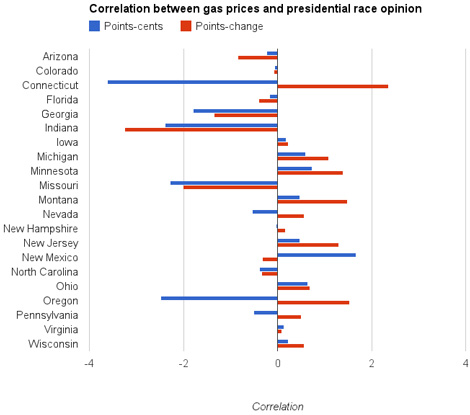For all of the talk about high gas prices during the campaign (see this debate recap), there’s a key question that hasn’t been answered: Do higher gas prices erode support for the president? (In the interest of maintaining our sanity, we’re going to ignore the fact that there is literally nothing that the president can do to affect prices.)

The New York Times looked at the issue this morning:
President Obama is lucky: prices at the pump have come down about 11 cents in the last month, and energy experts say they should continue to fall as the election approaches. Prices normally decline in the fall, and high gas prices in California are now easing after a series of refinery accidents a few weeks ago tightened supplies just when refiners were refitting their plants for seasonal changes in gasoline blends.
Perhaps more to the point, gasoline prices are below the national average of $3.75 a gallon in most of the swing states — Virginia, Florida, Iowa, Colorado, Michigan and Pennsylvania — that could determine the victor. Ohio, potentially the most pivotal state, has a price of $3.55 — among the cheapest in the nation.
The big exception is Nevada, where the average gallon of regular gasoline is $3.95, 20 cents above the national average.
That sort of answers the question. But we thought we could do better.
We pulled the most recent gas price data from GasBuddy.com and the most recent state polling average data from Real Clear Politics. Our goal: see if and by how much gas prices — and changes in gas prices — correlate to support for President Obama.
First, gas prices. Here’s a map of how much gas prices are below the national average, by state. If the number is negative, it indicates that the state’s price average is that much above the national average of $3.72.
[protected-iframe id=”0d8a357c7025b5d0bab9ec81cbf7d427-5104299-34907067″ info=”http://www.google.com/jsapi” width=”470″ height=”300″]
Immediately, something jumps out. The swing states of Ohio and Missouri are significantly darker than the rest of the country — meaning their gas prices are lower than average.
But that’s the price now. What about how the price has changed over the last day? Isn’t a spiking gas price more likely to spur a Romney vote than a high-but-consistent one?
[protected-iframe id=”25441ee8405559dcfdfba8758230a2bf-5104299-34907067″ info=”http://www.google.com/jsapi” width=”470″ height=”300″]
Here darker colors indicate prices dropping faster than the average. Again Ohio and Missouri are doing alright (though not as good as Alaska).
So let’s throw polling data into the mix. Most states — California, Alabama, New York, Arkansas — aren’t worth worrying about here since they are polling so heavily for one candidate or the other. They’re unlikely to flip positions no matter what happens to the price of gas. Real Clear Politics identifies 21 states as toss-ups. We took the current margin for Obama and Romney and compared it to the price of gas versus the average (in blue) and the change in price versus the average (in red).
If there were a relationship between gas price and political support, every number here would be positive. States that had lower gas prices would support Obama more, and vice versa.
Some states do what you’d expect. New Mexico has lower-than-average gas prices, so it more strongly supports President Obama. But its gas-price change is worse than average — prices are going up. So the correlation there is negative. Connecticut pays some of the highest prices in the nation, and supports Obama strongly, though prices are also dropping.
In short: no correlation. The likelihood that a state will vote for the president is not linked to the price of gas in the state.
We can learn one thing from this, though: While there’s nothing the president can do to affect gas prices, it appears, at least this cycle, that there’s not much gas prices can do to affect the president.





